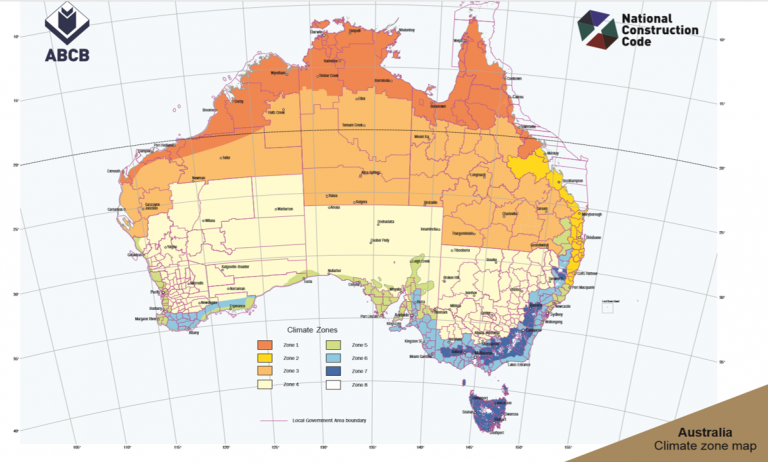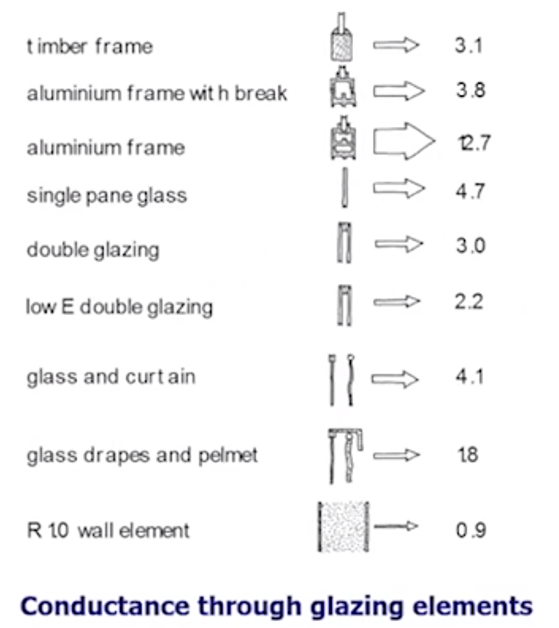Cool temperate zone heating is ideal for hydronic heating. Heat pumps are an ideal heat source, especially if matched with solar power. This is an efficient and effective way of heating and cooling if the home is well insulated. It will give you low operating costs and can be largely powered by your solar panels.
Cool Temperate zones have:
- Low humidity
- High diurnal range (temperature swings)
- Cold to very cold winters
- Hot dry summers

Heating and Cooling Design Considerations
If you are designing a new home or renovation in a Cool Temperate zone, consider these passive heating and cooling design principles to reduce your heating and cooling loads:
- Incorporate thermal mass internally as much as possible
- Insulate your internal thermal mass to prevent thermal bridging to the outside
- Optimise your eaves to allow solar radiation in winter but not in summer as sun tracks higher in the sky
- Maximise your window area in north facing walls & minimise it to the east, west and south
- Use high performance windows with low thermal conductance
- Provide thermal breaks on aluminium window frames
- Use shade devices such awnings & deciduous trees to maximise solar gain in winter and minimise it in summer
- Use cross ventilation & night time cooling in summer with orientation to the prevailing winds
- Make your inlet vents smaller than your outlet vents to encourage natural air flow through your home
- Protect your home from cold prevailing winds in winter
- Use reflective & bulk insulation to reduce heat loss in winter & heat gain in summer
- Apply insulation to ceilings, walls and floors
- Seal your building envelope to minimise heat losses & gains from convection currents
- Zone your home to reduce the heating & cooling load from unused rooms
Window Design
Carefully choose your windows because they are a significant source of heating loss or gain in a Cool Temperate zone. Also, your window type, size and orientation greatly affects your home energy rating. Choose high performing window frames and glazing, and size them appropriately for their orientation. Consider your windows as an assembly of elements where in total you are seeking low conductance, especially to the south, east and west.
The following table provides a guide to the conductance of common window assemblies. If single glazing is used then you should add drapes under pelmets to address the consequent heat loss and gain in winter and summer. If you choose aluminium frames then add thermal breaks to reduce the transmission of heat between inside and outside through the highly conductive aluminium frames.

Heating & Cooling System Design
The more you can incorporate passive design principles into your building design, the less you need to rely on mechanical heating and cooling. However, the typical power demand for heating and cooling in a Cool Temperate climate is around 40% of the total. Therefore, consider a heat pump hydronic heating and cooling system working with your solar power because it is particularly efficient and effective in a Cool Temperate zone. Unlike gas, a heat pump can reverse cycle to provide cooling through your hydronic system in summer.
Your power demand can be reduced by using your heating, cooling, water heating and other electrical appliances during the day when your solar panels are generating power. By running your heating and cooling system during the day, the thermal mass inside your home will absorb this heating or cooling energy and release it at night.
If you have a heat pump hydronic heating and cooling system then consider a larger buffer tank to store extra day time heating or cooling energy in the water for release into the evening. This acts like a battery. If your house is well insulated and has good internal thermal mass, then the heating or cooling you have produced during the day should hold well into the evening.
Ceiling Fans
Reduce the temperature you feel by around 4 degrees by using ceiling fans. These use very little power and are instantly effective. If you can keep your internal building mass cool during the day, then ceiling fans will likely be sufficient on hot summer days.
Heat Recovery Ventilation
Use Heat Recovery Ventilation during the day to reduce your heating and cooling load so that your heating and cooling system has less work to do. A good heat recovery ventilation system can transfer up to 92% of the heating or cooling in the outgoing stale air to the incoming fresh air.
Of course, open your windows and allow in the cool evening air when opportune to do so.
Water Heating
Reduce your energy demand for water heating by installing a solar or heat pump water heater. The advantage of a heat pump water heater over a solar water heater is that it does not take up roof space and is less costly to install. Both water heaters use about the same amount of power, which is about one quarter that of an electric element water heater.
If you choose a heat pump water heater you can set the timer to run it during the afternoon when the air is warmer and your solar panels are generating power. Also, your heat pump water heater will run more than 20% efficiently when the air temperature is 10 degrees higher, which is typical in the afternoon.
Solar Power
If you have solar panels, consider how best to use your appliances to reduce your power bills. It is 2 to 3 times better to use your power than export it to the grid when looking at the difference of what you are charged or paid for power. For more information on solar power, contact G-Store
Dish Washers, Clothes Washers and Clothes Dryers
Dish washers, clothes washers and clothes dryers have two things in common:
- They are discretionary appliances that can be run during the day and
- They use a lot of power
Your clothes dryer draws about 2kW, as does your dish washer on drying cycle. Connect your washing machine to your solar or heat pump hot water or it too will draw at least 2kW of power if heating water with its electric element. Plan to run these appliances during the day, consecutively, with the clothes dryer scheduled for the middle of the day when your solar production is greatest.
Design Questions
Contact us with your specific design questions, email us your plans and/or use our Quick Quote configurator for an indicative quote. We will be happy to review this and email you a written indicative quote as a starting point.
